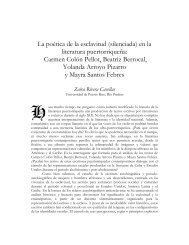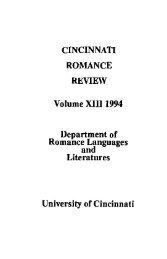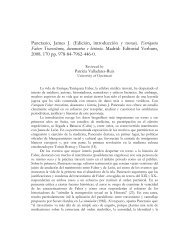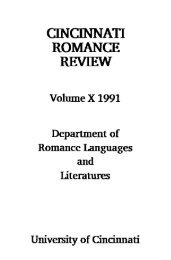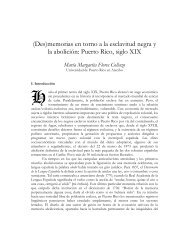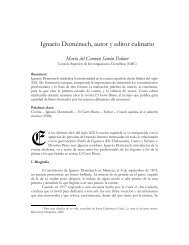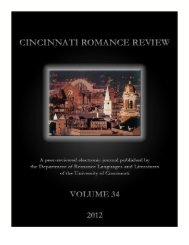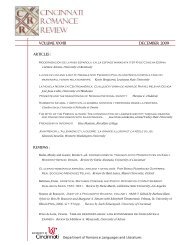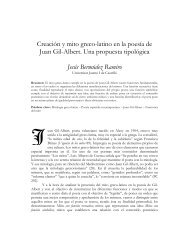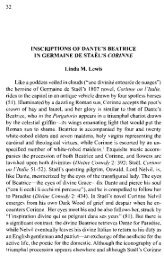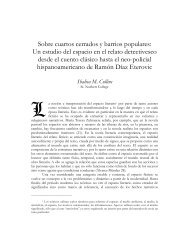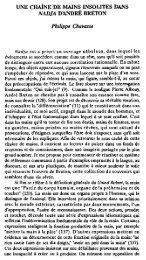Volume 30 (2011) - Cincinnati Romance Review
Volume 30 (2011) - Cincinnati Romance Review
Volume 30 (2011) - Cincinnati Romance Review
Create successful ePaper yourself
Turn your PDF publications into a flip-book with our unique Google optimized e-Paper software.
WRITING AFRICANS OUT OF THE RACIAL HIERARCHY<br />
Moreover, although he expressed appreciation of some elements of the<br />
indigenous past, his general view of indigenous people was similar to that of<br />
Vasconcelos and Gamio. He acknowledged, “After the discoveries of archaeologists and<br />
historians it is no longer possible to refer to these societies as savage or primitive<br />
tribes,” but he nonetheless referred to them stereotypically, emphasizing the false<br />
history of human sacrifice and referring to the “fascination or horror they inspire in us”<br />
(Paz 89). Furthermore, when comparing it to Rome and Byzantium, he remarked on the<br />
relatively short lifespan of the Aztec Empire, calling its collapse “pathetic” (94). And in<br />
terms of indigenous people in the present, Paz had little regard for them. While he<br />
criticized the other intellectuals of the revolution, he embraced Vasconcelos’s dream of<br />
a “raza cósmica.” In fact, his only critique of Vasconcelos was that his idea remained<br />
more theory than practice—that is, that it did not lead to enough racial mixing.<br />
More than his predecessors, Paz’s choice to write the African out of the<br />
Mexican racial body is apparent. Vasconcelos and Gamio circumvented the “problem”<br />
of Africans by avoiding acknowledging them in any meaningful manner. Paz refused to<br />
recognize Afro-Mexicans, but their absence is highlighted by his reference to “other”<br />
Africans. He began Chapter 2 by excluding people of African descent—and for that<br />
matter, pure-blooded indigenous people—from the category of “Mexican.” He wrote,<br />
“The Mexican, whether young or old, criollo or mestizo, general laborer or lawyer…”<br />
(29). Creole or mestizo, as though no other category could possibly exist. Yet Paz was<br />
clearly aware of an African influence in Mexico, even if he refused to acknowledge the<br />
Afro-Mexicans in his present. He discussed people of African descent in two contexts:<br />
First, as people who contributed to the category of “Iberian,” and who he usually<br />
referred to as “Moorish.” He only referred to this group in passing, mentioning, for<br />
example, “Our Spanish-Arabic inheritance” (36), and calling Mexicans, “Castilian and<br />
Moorish with Aztec markings” (153). The second group he discussed he called “blacks”<br />
or “African Americans,” meaning people of African descent in the U.S. Paz’s discussion<br />
of African Americans in the U.S. only came up once in the original volume of The<br />
Labyrinth of Solitude, and he quite pointedly distinguished them and their experiences<br />
from anything Mexican. He wrote, “If it is not possible to identify our character with<br />
that of submerged groups, it is also impossible to deny a close relationship… Servants,<br />
slaves, and races victimized by an outside power (the North American Negro for<br />
example) struggle against a concrete reality…” (72) in contrast to the Mexican, who<br />
struggled against himself. In the preface to the 1969 edition, Paz again mentioned<br />
people of African descent, but only in the United States. He discussed the Civil Rights<br />
movement and the “problem” that the United States faced at the time with “their<br />
blacks,” as though Mexico had no blacks of its own (219). Ironically, he made that<br />
statement just paragraphs after calling for “a recovery of our (Mexican) true history”<br />
(217).<br />
<strong>Cincinnati</strong> <strong>Romance</strong> <strong>Review</strong> <strong>30</strong> (Winter <strong>2011</strong>): 172-183.<br />
181



